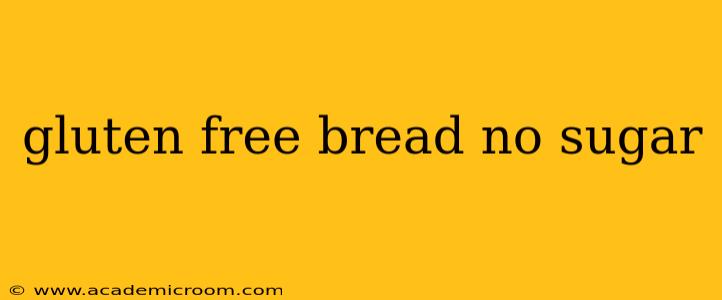Going gluten-free doesn't mean sacrificing delicious bread! Many people also seek sugar-free options for various dietary reasons, from managing blood sugar to simply reducing refined sugar intake. This guide explores the world of gluten-free, sugar-free bread, covering everything from ingredient choices to baking tips and tricks. We'll delve into frequently asked questions to help you make informed choices and enjoy truly satisfying loaves.
What are the Best Gluten-Free Flour Blends for Sugar-Free Bread?
The foundation of any good bread, gluten-free or otherwise, lies in the flour blend. Finding the right mix is crucial for achieving a texture that's both soft and structurally sound without relying on sugar for lift or moisture. Popular choices include:
- Almond flour: Offers a slightly nutty flavor and lends itself to denser loaves. It's naturally lower in carbohydrates than other gluten-free flours.
- Coconut flour: Highly absorbent, coconut flour needs careful handling. It's excellent for adding moisture and creating a slightly sweet, subtly coconut-flavored bread (though sugar-free recipes will minimize this sweetness).
- Cassava flour: A neutral-flavored option that works well in combination with other flours for a lighter texture.
- Brown rice flour: Provides a slightly nutty flavor and adds structure. Combining it with other flours often yields the best results.
- Tapioca starch/flour: Adds lightness and helps bind ingredients; usually used in combination with other flours.
Experimenting with different blends is key to discovering your preferred texture and taste. Many gluten-free bakeries offer pre-mixed blends specifically designed for bread-making.
Can I Make Gluten-Free Sugar-Free Bread at Home?
Absolutely! Many recipes are available online and in gluten-free cookbooks. The key to success lies in understanding the unique properties of gluten-free flours and using the right techniques. For instance, you may need to add extra binding agents like psyllium husk powder or xanthan gum to mimic the elasticity that gluten provides in traditional bread.
What are Some Good Substitutes for Sugar in Gluten-Free Bread?
While some recipes naturally incorporate sweetness from ingredients like fruit purees or maple syrup (used sparingly), completely avoiding added sugar requires careful ingredient selection. There are some alternatives you can consider:
- Fruit purees (used minimally): Unsweetened applesauce or pumpkin puree can add moisture and a hint of natural sweetness without significantly impacting the overall sugar count. Use small amounts to avoid making the bread overly moist.
- Sugar alcohols (erythritol, xylitol): These sugar alternatives have fewer calories and a lower glycemic index than regular sugar but should be used sparingly and with caution, as they can have laxative effects in large quantities. Always consult a doctor before adding sugar alcohols to your diet if you have any health concerns.
- Stevia or Monk fruit: These are natural, low-calorie sweeteners, but they can sometimes have an aftertaste. Use them judiciously, starting with small amounts.
Remember to always check the nutrition labels of any ingredients you use to ensure they align with your sugar-free goals.
How Do I Achieve a Good Texture in Sugar-Free Gluten-Free Bread?
Achieving a soft, fluffy texture in gluten-free, sugar-free bread is a challenge, but achievable with the right technique. Here are some tips:
- Proper hydration: Gluten-free flours absorb liquids differently than wheat flour. Using the correct amount of liquid is critical.
- Binding agents: Xanthan gum or psyllium husk powder are crucial for providing structure and mimicking the elasticity of gluten.
- Don't overmix: Overmixing can lead to a tough loaf. Mix only until just combined.
- Proper baking time and temperature: Using a reliable recipe and an oven thermometer ensures even baking.
Is Gluten-Free Sugar-Free Bread Healthy?
The health benefits of gluten-free, sugar-free bread depend on the specific ingredients used. A loaf made with wholesome, nutrient-rich flours and minimal added ingredients can be a healthier alternative to traditional bread for those with gluten intolerance or sensitivities and those managing their sugar intake. However, relying on highly processed gluten-free flours and other additives may negate any health benefits. Choosing recipes focusing on whole-grain options and minimizing added ingredients is key.
Where Can I Buy Gluten-Free Sugar-Free Bread?
Many health food stores and supermarkets now stock gluten-free bread, though sugar-free varieties may be more limited. Check the ingredient labels carefully to ensure the bread meets your specific dietary needs. Online retailers specializing in gluten-free products are another option. Increasingly, you will find specialized bakeries that cater to both gluten-free and sugar-free diets, offering freshly baked options.
This comprehensive guide offers a starting point for your exploration into the delicious world of gluten-free, sugar-free bread. Remember to experiment, adapt recipes, and discover the combinations that suit your palate and dietary requirements. Happy baking!
